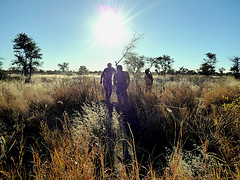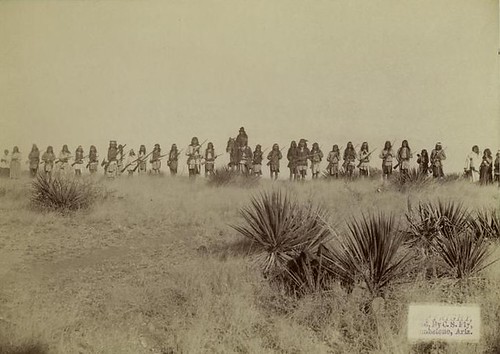Blog
Check this space for occasional updates and other items of interest.
_______
Entries in Hunter-gatherers (4)
Article -- Land Management Among Hunter-Gatherers: Questioning the Ubiquity Claims
This is my first article in some time, though the topic is one I began researching several years ago. I examine common claims concerning the pervasiveness of land management practices among hunter-gatherer societies.
It appears in Hunter/Gatherer, a student-run radical ecology journal. I’ve become frustrated in recent years with the lack of substantiation and pervasive confirmation bias in the popular media, so I chose with this paper to return to scholarly writing.
This is the first in what may be a series of two or three articles on the topic of traditional land management.
Available as a PDF:
Land Management Among Hunter-Gatherers: Questioning the Ubiquity Claims (PDF)
Abstract
Evidence that our industrial society, built on agricultural subsistence, is inherently ecologically destructive underlines the value in identifying which, if any, past human subsistence approaches have been ecologically benign. The traditional land management practiced by some hunter-gatherers is touted by some as a model of ecologically benign subsistence. In this paper I examine critically several broad assertions made commonly by proponents of this set of subsistence practices. These claims portray these practices as almost ubiquitous among human societies, in their impacts across land areas, and through time. Despite having been subjected to little scrutiny, these claims have contributed to the reputation, on the part of traditional land management, for ecological benignity. By analyzing them critically we can improve our understanding of traditional land management, laying a foundation for more effective examination of direct ecological impacts and long term consequences of this subsistence approach.
I was honored to receive from Gary Gripp his review of the article above. I’m not sure I truly lived up to all of Gary’s comments, but am gratified that, by his reading, I did manage to carry out the analysis with the intellectual honesty that should be a cornerstone of any scholarly writing.
Beyond the review elements, this piece is well worth reading for Gary’s reactions and his thoughts on the human relationship with the earth. Gary writes on our earth crisis and other topics, some of his work appearing on his blog at wildearthman.com. Here's a link to the review:
Confronting some of the Challenges of Intellectual Integrity
A second paper on the topic of hunter-gatherer land management is progressing well. Much of the material was compiled some time ago, but has required revision, updating, and reorganization. I will post another follow-up when it is closer to publication somewhere.
As a smalll addendum to this paper, I came upon a paper reporting some reasons for burning among the Ju/'huansi, for land management purposes, that add to what I previously identified. See p. 163 of:
Hitchcock, R. K., Yellen, J. E., Gelburd, D. J., Osborn, A. J., & Crowell, A. L. (1996) Subsistence hunting and resource management among the Ju/'hoansi of Northwestern Botswana. African Study Monographs, 17(4): 153-220.
This does not affect my paper's argument, but may be of some interest to those exploring HG land management in detail.
Article -- Agriculture: Ending the World as We Know It
[6/2014 - Note: I've long preferred an earlier working title I had used for this article: Agriculture: The Beginning and End of Civilization]
My first full article in a year and a half, Agriculture: ending the world as we know it, is out today in the Canyon Country Zephyr. Published by Jim Stiles, The Zephyr, based in Southern Utah, has been taking independent, uncompromising stands on environmental matters for over twenty years. That makes it a good fit for this piece falling far outside the standard environmental thinking dominating the mainstream media.
The article looks at the unsustainability of agriculture and, therefore, civilization. It examines the human break from nature in the origin of agriculture ten thousand years ago and where we are headed as a result. We cannot avoid tough times ahead, though we do have options available for softening the landing. Ultimately, we need to acknowledge the obvious but fundamental point that hunting and gathering is the only human way of life we know to be sustainable.
One point I'd like to have covered more thoroughly in the article is the notion that a horticultural alternative such as large scale permaculture-based food growing could simply replace agriculture. The text of a footnote to a previous blog post (see below) adds a worthwhile clarification:
On a large enough scale, even a major improvement such as permaculture would seem to suffer from a similar problem of transforming the land excessively for human consumption. It is intended, however, to be practiced on a scale small enough -- and with ethical constraints against large populations -- that it might prove sustainable under conditions of a much smaller human population. This is not to suggest it as an "alternative" to agriculture, without which humans did quite well for most of our history. As an approach to small-scale gardening -- something practiced by many hunter-gatherers -- it makes great sense. Once we begin to depend, though, on growing food as our primary means of subsistence, upping the scale by altering large tracts of habitat, taking control of our food supply by creating and storing unnecessary surpluses, the problems start. (I am aware of nothing concrete, by the way, built into the practice of permaculture which would prevent population growth. I welcome information to the contrary.)
That said, there will surely be a transitional period, post-civilization, when permaculture and related approaches to food production will be essential to many of those shifting toward true sustainability, even prior to a full move into hunting and gathering.
Related to the note above, please also see the more recent notes following the previous post.
The gist
[Please see the updates under this post. Until a likely article on horticulture and indigenous land management, they will serve as a first pass at the subject.]
[Revised 4/30/16]
Time for an update listing some simple, related points which underlie my thinking today.
A fuller version of these and other ideas will appear in a new article I've written. (Here's a link.)
So here's the gist...
Civilization is inherently destructive and unsustainable. A key reason for this is that civilization is founded on agriculture. Agriculture circumvents the natural processes which regulated human population numbers prior to its inception. It is the basic ecological factor which has caused our numbers to overshoot carrying capacity so enormously. Along the way, agriculture destroys topsoil and ecosystems, tearing down the web of life, our global life support system. Agriculture is therefore unsustainable.
Civilization will therefore come to an end. Because the human population is deeply into overshoot, we know that ending will involve a tremendous decline in our numbers. Converging issues such as oil depletion, climate change, topsoil and groundwater depletion, and the human-caused sixth mass extinction event in Earth's history suggest this may occur not many centuries from now, but sooner. How much sooner, no one can say. Though this signals the potential for tough times ahead, it also means an end to what's killing the earth.
Immediate-return hunting and gathering (see below) is arguably the only human way of living proven ecologically sustainable. It thus makes great sense to study it to learn all we can.
In light of the progressive destruction of Earth's life support systems, we see the reason for calls for a resistance movement from writers such as Zerzan and Jensen. Every day civilization remains intact brings more destruction of the web of life. Yet the potential for unintended consequences of such resistance actions presents a thorny dilemma to would-be advocates.
An easier yet tremendously valuable option is to do what we can through established conservation measures to protect as much habitat and biodiversity as possible, helping to preserve those things for the future. One of the most important and ambitious conservation projects today involves "rewilding" by restoring, protecing, and connecting wildlands corridors containing large predators on a continental scale. That and other projects are represented in "organizations" page on this site.
If you're interested in this topic, see the "core ecological issues" page for relevant links.
_______
Image source: David Barrie's photostream, flickr.com, creative commons license
For a fuller examination of these issues please see my more recent article, Agriculture: Ending the world as we know it. More recent updates appear below.
When investigating hunter-gatherers, it's worth keeping a couple of things in mind. First, make sure you are looking at hunter-gatherers. I often see people, even prominent writers, attribute characteristics to hunter-gatherers only to find they are talking about some society which is actually agrarian or pastoral.
Second, it is crucial to understand the differences between "immediate-return" and "delayed-return" hunter-gatherers. As far as we know, the former term (roughly synonymous with "simple" hunter-gatherers) describes our ancestors' subsistence for the great bulk of human history. (See, e.g., Berman's Wandering God, 2000, p. 54; Kelly's The Foraging Spectrum, 2007, p. 304) Moreover, it's clear any debate on the matter becomes increasingly unreasonable as we work our way back through human existence. The first delayed-return societies may have begun to emerge during the Upper Paleolithic. Among these were also the first tribal societies, immediate-return societies having been composed of bands, not tribes.
Anthropologist Ernest S. Burch, Jr. wrote:
"In my judgment, the most definitive division of small-scale societies identified so far is not between foraging and agrarian, but between immediate-return and delayed-return societies... or nonstoring and storing societies... As Testart... put it,
Agriculturalists and storing hunter-gatherers together are neatly in opposition to nonstoring hunter-gatherers. ...
Immediate-return or 'generalized' hunter-gatherer societies are so unlike all others that, as Birdsell... once noted, it is difficult even for anthropologists who have not personally experienced one to conceive how they can exist; it is almost impossible for nonanthropologists to do so."
I've observed that few nonanthropologists seem truly to appreciate this distinction. I belive even some anthropologists haven't thought much about it. Yet it makes all the difference. (For more see the "core ecological issues" page.)
Update on "traditional land management"
I've completed the first of two, perhaps three papers on "traditional land management" (AKA protoagriculture, low level food production, indigenous land management, etc.). Much of the material for the next two papers is completed. This has been a long process, immersing myself in the anthropological and ecological literatures, and relearning much about the scholarly writing process. I expect the first paper to be published fairly soon by a student-run radical ecology journal. I will post a link to it in the "Articles" section when it's available.
These papers should provide useful reading for anyone wishing to go a large step beyond what I wrote above and in my article on agriculture.
It wasn't long ago
Once I moved about like the wind. Now I surrender to you and that is all. -- Geronimo
This is a photo (slightly cropped to fit) of the last band of aboriginal people in North America to fight and resist the takeover of their landbase by the United States government. Numbering about 39 men, women, and children, this band of Apaches including Naiche, son of Cochise (on horseback) and Geronimo (standing in front of Naiche), evaded capture by a quarter of the US army and three thousand Mexican troops, finally turning themselves in, ending a key chapter in human history.
The ending of lifeways apart from civilization among the aboriginal peoples of North America happened in about the same way it has happened worldwide. Central among proximate causes has been the growth of the population of those of us in civilization. The root cause has been civilization itself.
The people in the photo are standing on a spot in what is today southern Arizona. Twenty years after the photo was taken, my grandmother took a teaching job in a small town not far from that spot. She lived into the late 1980s. Indeed, it wasn't long ago that people still lived freely, as had their ancestors, in ways foreign to agriculture-based industrial civilization, right here where we in the United States live today. [1] [2]
Likewise, relative to the whole of human history, it has been only in the last instant that not everyone has lived in small bands, foraging and hunting for food, attuned to rather than trying to separate themselves from nature. [3]
Today as we puzzle over where we went wrong ecologically and socially, and scramble to find some way to fix things (prevented by those in power from taking meaningful action), we forget that for 3 million years we had many variations on a basic system which worked, made for fulfilling lives, and was sustainable.
I expect to focus much more on this topic in future writing.
For some insightful references see the section on core ecological issues and the relevant books in the book section. For an engaging source on the events surrounding the photo above, try David Roberts' Once They Moved Like the Wind.
_______
[1] During much of their history, and certainly at the time of the photo, the Apache were not strictly hunter-gatherers. Owing to their roots, however, their surrender is an appropriate symbol for the loss of a way of life based not on agriculture, attuned to the natural world.
[2] While Geronimo's surrender marked the official end of the "Apache wars," reports suggest remnant bands of Apaches continued to live freely in the mountains of Mexico for years afterward.
[3] The period since the dawn of agriculture 10 thousand years ago to the present represents about one third of one percent of human history.



